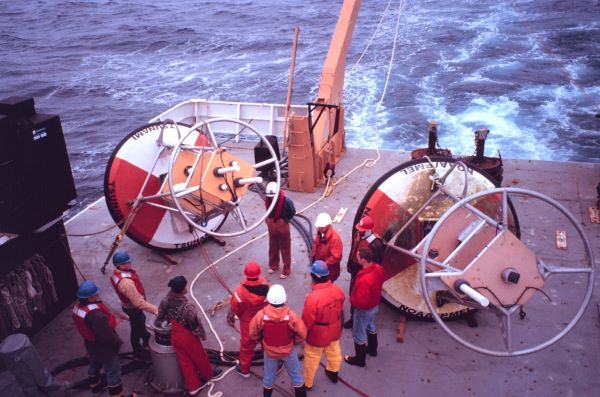SEJournal Online is the digital news magazine of the Society of Environmental Journalists. Learn more about SEJournal Online, including submission, subscription and advertising information.
 |
| Crew members on the NOAA ship Ronald H. Brown prepare oceanographic buoys for deployment. Photo: Commander Emily B. Christman, NOAA Corps, NOAA Photo Library. |
Reporter’s Toolbox: NOAA Data Portal Is a Great Home Port for Environmental Journalists
By Joseph A. Davis
Everybody talks about climate change. NOAA actually measures it. Knowing how to get at data from the National Oceanic and Atmospheric Administration will eventually be a Swiss Army knife for environmental journalists reporting on this heating-up world.
The first challenge for many of us is imagining and appreciating how vast NOAA’s data stores are. A close second is applying them to help audiences understand how important the seas and atmosphere are to human life.
NOAA is trying to help, through its Data Discovery Portal. This is a single web page that holds out the promise of leading you to some 65,438 NOAA datasets in — we hope — a coherent and relevant way.
Starting from the portal, there are two ways in. One is the traditional NOAA Data Catalog. The other, more user-friendly, option is a new search tool called OneStop. An important limitation of OneStop is that it only leads to data held by the agency’s National Centers for Environmental Information. But that’s a ton.
Where the data comes from
Instruments — usually. Think of a tidal gauge. Or a thermometer. That’s basically what NOAA does, but there’s much more to their gear than your standard hardware store devices.
NOAA has a fleet of at least 15 research vessels. Most are engaged in oceanographic research. Others do hydrographic and fisheries surveys. These ships work out of home ports everywhere from Hawaii to Massachusetts. Collectively, they conduct more than 100 missions each year.
Another source is NOAA’s huge fleet of data buoys. They measure a lot of things — such as temperature, salinity, currents, nitrate, chlorophyll and the partial pressure of carbon dioxide in seawater — often in remote and rough seas. They can even help measure complex phenomena like the El Niño Southern Oscillation, which has a huge impact on both oceans and continental weather. The buoys actually have their own database, which ultimately folds into NOAA’s data universe.
NOAA’s saildrones have actually
ventured into the heart of
hurricanes — with cameras rolling.
And let’s not forget the data-collecting drones. NOAA’s saildrones have actually ventured into the heart of hurricanes — with cameras rolling. Other autonomous and remotely-piloted instrument platforms include drifters and gliders. There are also robots known as autonomous underwater vehicles.
Last but not least, NOAA owns and operates nine satellites, whose only job is to observe the Earth in many of its aspects.
Using the data smartly
You may not discover the story you need the data for until you discover the data — and realize how sprawling the NOAA institutional network is.
The portal page itself offers the hope and promise of using the data smartly. It does this (at least OneStop does) by helping you do intelligent searches by topic as well as by platforms and types of data.
Searches can be guided by six major topic areas: weather, climate, satellites, fisheries, coasts and oceans. You can also search by keyword, such as tides or currents. And you can filter the results by the location or date of the data or other attributes.
A hint to the hip: A lot of really smart scientists are already quite busy using and understanding NOAA data. One of the best routes for going in deeper is to find and talk to them. For instance, you might start by looking around at local universities and research centers.
Joseph A. Davis is a freelance writer/editor in Washington, D.C. who has been writing about the environment since 1976. He writes SEJournal Online's TipSheet, Reporter's Toolbox and Issue Backgrounder, and curates SEJ's weekday news headlines service EJToday and @EJTodayNews. Davis also directs SEJ's Freedom of Information Project and writes the WatchDog opinion column.
* From the weekly news magazine SEJournal Online, Vol. 7, No. 29. Content from each new issue of SEJournal Online is available to the public via the SEJournal Online main page. Subscribe to the e-newsletter here. And see past issues of the SEJournal archived here.

















